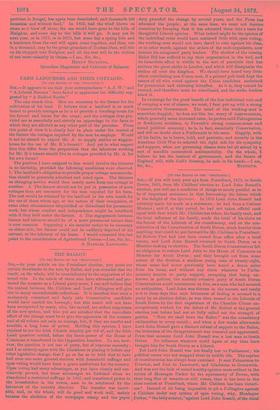A PROPHECY.
[TO THE EDITOR OF THE " SPEOTATOR.1
SIR,—We often hear of extraordinary instances of the memory of memorable events passing away, but the most extraordinary that
has ever come under my notice is to be found in Dr. Hunter's "Orissa." There is a chapter headed "The Calamities of Orissa." It is plain that Dr. Hunter visited many parts of the province, examined the Record-rooms, inquired diligently, and was desirous of describing all the calamities that had befallen Orissa, and all the calamities to which the province is still liable. But he never heard mention of the hurricane of October, 1831, in which twenty- two thousand five hundred persona were drowned in half an hour, and after which several thousand more died of starvation and exposure; or of the hurricane of November, 1832, which in violence greatly exceeded the storm of 1831, but the wind when most violent being off shore instead of on shore, none were drowned.
In October, 1831, the sea made a breach in the road which passes through the province from north to south where it is nine miles from high-water mark. All having life, human beings, cattle, wild beasts, &c., were drowned, and left in heaps eight and ten feet high against the road. This was north of Balasore. South of Balasore, when examining the country, I stood under a tree with the only survivor in a village containing seven or eight hundred inhabitants. Late in the evening, said the survivor of 1831, the wind was very strong on shore and the tide rising. Several of the inhabitants went down to the beach. Those who had witnessed the storm of 1823 proposed to go inland ; the younger ones would not believe that the sea could harm them, and voted for remaining. All were drowned except my informant, who was up in the tree under which we were standing, and twice the sea went over him. When he came down all was dry, but, as he expressed it, not a cat left.
When I was last in Orissa, in 1853, after twenty-two years, I found many parts in which not a being had been left in 1831 again densely populated. When I searched in the record-room at Balasore for the map I had made of the country inundated from the Subenreeka river to the Dumrah river, it could not be found, aud nobody had ever seen it or heard of it. And now, after forty years, a chapter on the calamities of Orissa ignores altogether the hurricanes of 1831 and 1832, and I dare say those who inhabit the country between the high road and the sea have no idea that the wave passed over the village sixteen or eighteen feet deep. When old Toolsee Dass tells of how he was carried on the top of a choppah (thatched roof) eight miles inland, and when daylight broke found himself high and dry on the Cuttack road, the sea again quite out of sight and he alone alive amidst heaps of men, women, children, goats, buffaloes, and wild beasts, they look upon him as an old Jhoot- wallah, (liar) and have entire faith in the future good behaviour of the storm-wave.
But it will come again. Evidently it was very near last month. The papers say,—" The station of Balasore, once one of the prettiest in Bengal, has again been demolished, and thousands left bowlegs and without food." In 1832, had the wind blown on share as it blew off shore, the sea would have gone to the hills of Neilghur, and some day to the hills it will go. It may not be next year, or in 1973, or in 2073, but some day a spring tide and a Juuricane from the east will again come together, and then, one in a thousand, may be the great-grandson of Toulsee Dass, will ride on his choppah into Neilghur, and all the rest will be the victims of one more calamity in Orissa.-1 am, Sir, &c., HENRY RICK ETTS, Quondam Magistrate and Collector of Balasore.



































 Previous page
Previous page